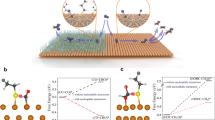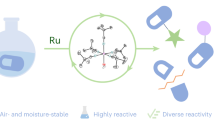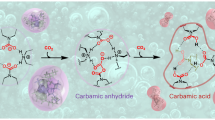Abstract
Electrochemical two-electron water oxidation is a promising route for renewable and on-site H2O2 generation as an alternative to the anthraquinone process. However, it is currently restricted by low selectivity due to strong competition from the traditional four-electron oxygen evolution reaction, as well as large overpotential and low production rates. Here we report an interfacial engineering approach, where by coating the catalyst with hydrophobic polymers we confine in situ produced O2 gas to tune the water oxidation reaction pathway. Using carbon catalysts as a model system, we show a significant increase of the intrinsic H2O-to-H2O2 selectivity and activity compared to that of the pristine catalyst. The maximal H2O2 Faradaic efficiency was enhanced by sixfold to 66% with an overpotential of 640 mV, under which a H2O2 production rate of 23.4 µmol min−1 cm−2 (75.2 mA cm−2 partial current) was achieved. This approach was successfully extended to nickel metal, demonstrating the wide applicability of our local gas confinement concept.
This is a preview of subscription content, access via your institution
Access options
Access Nature and 54 other Nature Portfolio journals
Get Nature+, our best-value online-access subscription
$29.99 / 30 days
cancel any time
Subscribe to this journal
Receive 12 digital issues and online access to articles
$119.00 per year
only $9.92 per issue
Buy this article
- Purchase on Springer Link
- Instant access to full article PDF
Prices may be subject to local taxes which are calculated during checkout




Similar content being viewed by others
Data availability
The data that support the plots within this paper and other findings of this study are available from the corresponding authors on reasonable request.
References
Perry, S. C. et al. Electrochemical synthesis of hydrogen peroxide from water and oxygen. Nat. Rev. Chem. 3, 442–458 (2019).
Shen, R. et al. High-concentration single atomic Pt sites on hollow CuSx for selective O2 reduction to H2O2 in acid solution. Chem 5, 2009–2110 (2019).
Campos‐Martin, J. M., Blanco‐Brieva, G. & Fierro, J. L. Hydrogen peroxide synthesis: an outlook beyond the anthraquinone process. Angew. Chem. Int. Ed. 45, 6962–6984 (2006).
Kuttassery, F. et al. One electron‐initiated two‐electron oxidation of water by aluminum porphyrins with earth’s most abundant metal. ChemSusChem 10, 1909–1915 (2017).
Remello, S. N. et al. Two-electron oxidation of water to form hydrogen peroxide catalysed by silicon-porphyrins. Sustain. Energy Fuels 2, 1966–1973 (2018).
Mathew, S. et al. Two‐electron oxidation of water through one‐photon excitation of aluminium porphyrins: molecular mechanism and detection of key intermediates. ChemPhotoChem 2, 240–248 (2018).
Yang, S. et al. Toward the decentralized electrochemical production of H2O2: a focus on the catalysis. ACS Catal. 8, 4064–4081 (2018).
Edwards, J. K. & Hutchings, G. J. Palladium and gold-palladium catalysts for the direct synthesis of hydrogen peroxide. Angew. Chem. Int. Ed. 47, 9192–9198 (2008).
Kim, H. W. et al. Efficient hydrogen peroxide generation using reduced graphene oxide-based oxygen reduction electrocatalysts. Nat. Catal. 1, 282–290 (2018).
Lu, Z. et al. High-efficiency oxygen reduction to hydrogen peroxide catalysed by oxidized carbon materials. Nat. Catal. 1, 156–162 (2018).
Siahrostami, S. et al. Enabling direct H2O2 production through rational electrocatalyst design. Nat. Mater. 12, 1137–1143 (2013).
Izgorodin, A., Izgorodina, E. & MacFarlane, D. R. Low overpotential water oxidation to hydrogen peroxide on a MnOx catalyst. Energy Environ. Sci. 5, 9496–9501 (2012).
Shi, X. et al. Understanding activity trends in electrochemical water oxidation to form hydrogen peroxide. Nat. Commun. 8, 701 (2017).
Kelly, S. et al. ZnO as an active and selective catalyst for electrochemical water oxidation to hydrogen peroxide. ACS Catal. 9, 4593–4599 (2019).
Han, L. et al. In-plane carbon lattice-defect regulating electrochemical oxygen reduction to hydrogen peroxide production over nitrogen-doped graphene. ACS Catal. 9, 1283–1288 (2019).
Zhao, K. et al. Enhanced H2O2 production by selective electrochemical reduction of O2 on fluorine-doped hierarchically porous carbon. J. Catal. 357, 118–126 (2018).
Jiang, Y. et al. Selective electrochemical H2O2 production through two‐electron oxygen electrochemistry. Adv. Energy Mater. 8, 1801909 (2018).
Fuku, K., Miyase, Y., Miseki, Y., Gunji, T. & Sayama, K. Enhanced oxidative hydrogen peroxide production on conducting glass anodes modified with metal oxides. ChemistrySelect 1, 5721–5726 (2016).
Kanan, M. W. & Nocera, D. G. In situ formation of an oxygen-evolving catalyst in neutral water containing phosphate and Co2+. Science 321, 1072–1075 (2008).
Finke, C. E. et al. Enhancing the activity of oxygen-evolution and chlorine-evolution electrocatalysts by atomic layer deposition of TiO2. Energy Environ. Sci. 12, 358–365 (2019).
Song, F. & Hu, X. Exfoliation of layered double hydroxides for enhanced oxygen evolution catalysis. Nat. Commun. 5, 4477 (2014).
Suntivich, J., May, K. J., Gasteiger, H. A., Goodenough, J. B. & Shao-Horn, Y. A perovskite oxide optimized for oxygen evolution catalysis from molecular orbital principles. Science 334, 1383–1385 (2011).
McCrory, C. C., Jung, S., Peters, J. C. & Jaramillo, T. F. Benchmarking heterogeneous electrocatalysts for the oxygen evolution reaction. J. Am. Chem. Soc. 135, 16977–16987 (2013).
Zhang, B. et al. Homogeneously dispersed multimetal oxygen-evolving catalysts. Science 352, 333–337 (2016).
Zheng, X. et al. Theory-driven design of high-valence metal sites for water oxidation confirmed using in situ soft X-ray absorption. Nat. Chem. 10, 149–154 (2018).
Viswanathan, V., Hansen, H. A. & Nørskov, J. K. Selective electrochemical generation of hydrogen peroxide from water oxidation. J. Phys. Chem. Lett. 6, 4224–4228 (2015).
Park, S. Y. et al. CaSnO3: an electrocatalyst for two-electron water oxidation reaction to form H2O2. ACS Energy Lett. 4, 352–357 (2018).
Xu, W., Lu, Z., Wan, P., Kuang, Y. & Sun, X. High‐performance water electrolysis system with double nanostructured superaerophobic electrodes. Small 12, 2492–2498 (2016).
Lu, Z. et al. Superaerophilic carbon‐nanotube‐array electrode for high‐performance oxygen reduction reaction. Adv. Mater. 28, 7155–7161 (2016).
Yu, C., Zhang, P., Wang, J. & Jiang, L. Superwettability of gas bubbles and its application: from bioinspiration to advanced materials. Adv. Mater. 29, 1703053 (2017).
Lv, K. et al. Hydrophobic and electronic properties of the E‐MoS2 nanosheets induced by FAS for the CO2 electroreduction to syngas with a wide range of CO/H2 ratios. Adv. Funct. Mater. 28, 1802339 (2018).
Tang, C., Cheng, N., Pu, Z., Xing, W. & Sun, X. NiSe nanowire film supported on nickel foam: an efficient and stable 3D bifunctional electrode for full water splitting. Angew. Chem. Int. Ed. 54, 9351–9355 (2015).
Wang, J., Zhong, Hx, Qin, Yl & Zhang, Xb An efficient three‐dimensional oxygen evolution electrode. Angew. Chem. Int. Ed. 52, 5248–5253 (2013).
Park, S. Y. et al. CaSnO3: an electrocatalyst for 2-electron water oxidation reaction to form H2O2. ACS Energy Lett. 4, 352–357 (2018).
Fuku, K. & Sayama, K. Efficient oxidative hydrogen peroxide production and accumulation in photoelectrochemical water splitting using a tungsten trioxide/bismuth vanadate photoanode. Chem. Commun. 52, 5406–5409 (2016).
Shi, X., Zhang, Y., Siahrostami, S. & Zheng, X. Light‐driven BiVO4–C fuel cell with simultaneous production of H2O2. Adv. Energy Mater. 8, 1801158 (2018).
Coplen, T. B. Normalization of oxygen and hydrogen isotope data. Chem. Geol. 72, 293–297 (1988).
Harris, P. Fullerene-related structure of commercial glassy carbons. Philos. Mag. 84, 3159–3167 (2004).
Chen, S. et al. Defective carbon-based materials for the electrochemical synthesis of hydrogen peroxide. ACS Sust. Chem. Eng. 6, 311–317 (2017).
Siahrostami, S. & Vojvodic, A. Influence of adsorbed water on the oxygen evolution reaction on oxides. J. Phys. Chem. C 119, 1032–1037 (2014).
Casalongue, H. S. et al. Direct observation of the oxygenated species during oxygen reduction on a platinum fuel cell cathode. Nat. Commun. 4, 2817 (2013).
Karlberg, G. & Wahnström, G. Density-functional based modeling of the intermediate in the water production reaction on Pt (111). Phys. Rev. Lett. 92, 136103 (2004).
Patel, A. M. et al. Theoretical approaches to describing the oxygen reduction reaction activity of single atom catalysts. J. Phys. Chem. C 122, 29307–29318 (2018).
Mathew, K., Sundararaman, R., Letchworth-Weaver, K., Arias, T. & Hennig, R. G. Implicit solvation model for density-functional study of nanocrystal surfaces and reaction pathways. J. Chem. Phys. 140, 084106 (2014).
Yan, H., Xu, B., Shi, S. & Ouyang, C. First-principles study of the oxygen adsorption and dissociation on graphene and nitrogen doped graphene for Li-air batteries. J. Appl. Phys. 112, 104316 (2012).
Ni, S., Li, Z. & Yang, J. Oxygen molecule dissociation on carbon nanostructures with different types of nitrogen doping. Nanoscale 4, 1184–1189 (2012).
He, G., Liang, T., Wang, Q., Xu, M. & Liu, Y. Increased permeability of oxygen atoms through graphene with ripples. Soft Matter 13, 3994–4000 (2017).
McKillop, A. & Sanderson, W. R. Sodium perborate and sodium percarbonate: further applications in organic synthesis. J. Chem. Soc. Perkin Trans. I 1, 471–476 (2000).
Jiang, K. et al. Transition-metal single atoms in a graphene shell as active centers for highly efficient artificial photosynthesis. Chem 3, 950–960 (2017).
Han, N. et al. Nitrogen-doped tungsten carbide nanoarray as an efficient bifunctional electrocatalyst for water splitting in acid. Nat. Commun. 9, 924 (2018).
Kresse, G. & Joubert, D. From ultrasoft pseudopotentials to the projector augmented-wave method. Phys. Rev. B 59, 1758 (1999).
Kresse, G. & Furthmüller, J. Efficiency of ab-initio total energy calculations for metals and semiconductors using a plane-wave basis set. Comput. Mater. Sci. 6, 15–50 (1996).
Wellendorff, J. et al. Density functionals for surface science: exchange-correlation model development with Bayesian error estimation. Phys. Rev. B 85, 235149 (2012).
Blöchl, P. E. Projector augmented-wave method. Phys. Rev. B 50, 17953 (1994).
Nørskov, J. K. et al. Origin of the overpotential for oxygen reduction at a fuel-cell cathode. J. Phys. Chem. B 108, 17886–17892 (2004).
Kim, K.-W., Kuppuswamy, M. & Savinell, R. Electrochemical oxidation of benzene at a glassy carbon electrode. J. Appl. Electrochem. 30, 543–549 (2000).
Acknowledgements
This work was supported by Rice University. H.W. is a CIFAR Azrieli Global Scholar in the Bio-inspired Solar Energy Programme. C.X. acknowledges support from a J. Evans Attwell-Welch Postdoctoral Fellowship provided by the Smalley-Curl Institute. K.C. acknowledges a grant (9455) from VILLUM FONDEN. S.S. acknowledges the support from the University of Calgary’s Canada First Research Excellence Fund Program, the Global Research Initiative in Sustainable Low Carbon Unconventional Resources. S.R. and S.B. acknowledge funding from US Department of Energy, Office of Science, Office of Basic Energy Sciences, Chemical Sciences, Geosciences, and Biosciences Division, Catalysis Science Program to the SUNCAT Center for Interface Science and Catalysis. This work was performed in part at the Shared Equipment Authority (SEA) at Rice University. The authors acknowledge L. Fan for the design of the scheme in Fig. 3. The authors also acknowledge Q. Jiang, T. Sun and Z. Lu for their support to the experiment and useful discussions.
Author information
Authors and Affiliations
Contributions
C.X. and H.W. conceptualized the project. H.W., K.C. and S.S. supervised the project. C.X. synthesized the catalysts, conducted the catalytic tests and the related data processing, and performed materials characterization and analysis with the help of K.J., F.C. and X.S. S.B. and S.R. performed the theoretical study. C.X. and H.W. wrote the manuscript with support from all authors.
Corresponding authors
Ethics declarations
Competing interests
The authors declare no competing interests.
Additional information
Publisher’s note Springer Nature remains neutral with regard to jurisdictional claims in published maps and institutional affiliations.
Supplementary information
Supplementary Information
Supplementary Figs. 1–18, Table 1, Note 1 and references.
Supplementary Dataset 1
Atomic coordinates of the optimized computational models.
Supplementary Video 1
Water oxidation of pristine GC under 2.05 V versus RHE.
Supplementary Video 2
Water oxidation of 300-GC under 2.05 V versus RHE.
Supplementary Video 3
Water oxidation of 200-GC under 2.05 V versus RHE.
Supplementary Video 4
Organic dye degradation using generated H2O2 solution.
Supplementary Video 5
Organic dye degradation using extracted solid H2O2 (Speed up, three times).
Rights and permissions
About this article
Cite this article
Xia, C., Back, S., Ringe, S. et al. Confined local oxygen gas promotes electrochemical water oxidation to hydrogen peroxide. Nat Catal 3, 125–134 (2020). https://doi.org/10.1038/s41929-019-0402-8
Received:
Accepted:
Published:
Issue Date:
DOI: https://doi.org/10.1038/s41929-019-0402-8
This article is cited by
-
Concurrent oxygen reduction and water oxidation at high ionic strength for scalable electrosynthesis of hydrogen peroxide
Nature Communications (2023)
-
Energy-saving and product-oriented hydrogen peroxide electrosynthesis enabled by electrochemistry pairing and product engineering
Nature Communications (2023)
-
Electrochemical generation of hydrogen peroxide from a zinc gallium oxide anode with dual active sites
Nature Communications (2023)
-
Dipole field in nitrogen-enriched carbon nitride with external forces to boost the artificial photosynthesis of hydrogen peroxide
Nature Communications (2023)
-
The practice of reaction window in an electrocatalytic on-chip microcell
Nature Communications (2023)



